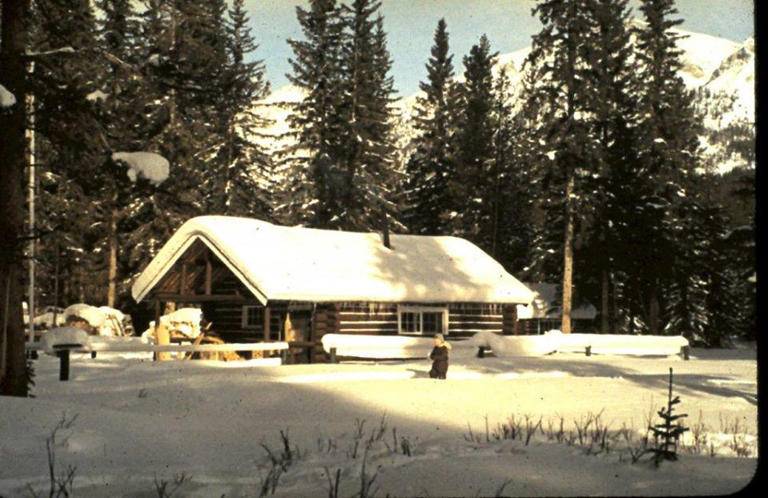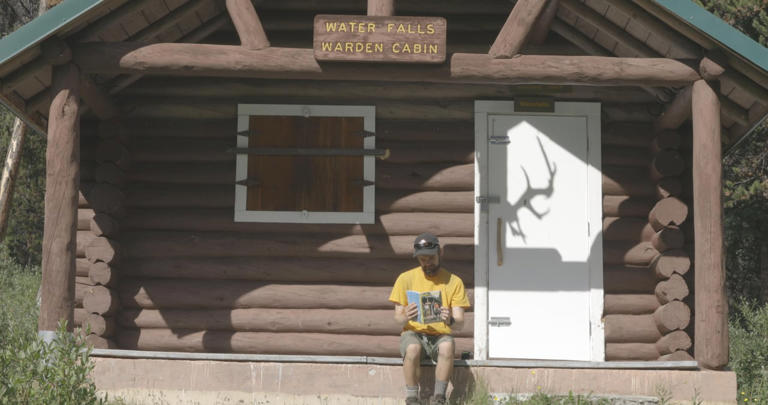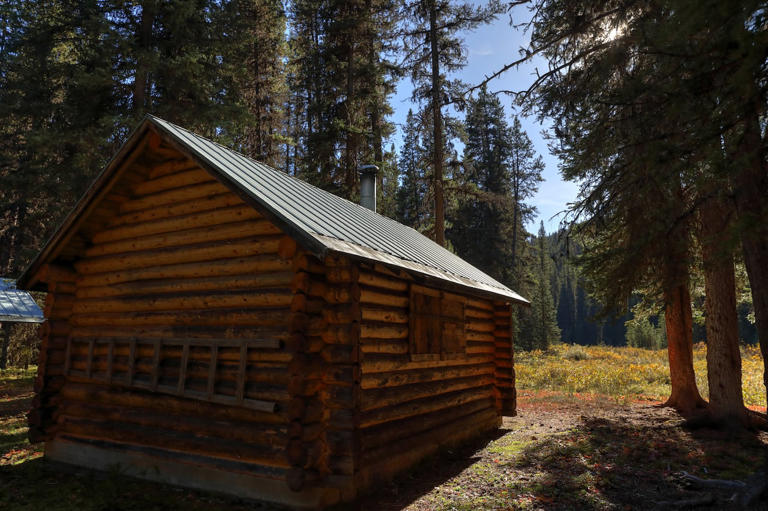History hiding in Jasper's backcountry: Old warden cabins find new use, value in national park
Decades ago, the cabins were once home to young families.
Loni Klettl's father was a park warden from 1955 to 1985 and she lived in the Blue Creek cabin as a newborn in the winter of 1959.
"There are all these stories of bears eating all the groceries, frozen diapers," said Klettl.
Klettl and her twin brother, Howie, took their first steps in the two-bedroom building along the North Boundary Trail of the park.

The Blue Creek cabin in 1959, where Loni Klettl lived when she was born. Her father served as a park warden in Jasper from 1955-1985
(Submitted by Loni Klettl)© Provided by cbc.ca
There was a view from the porch of mountaintops and sunny meadows, a wood stove and a registry that tracked its residents over the years.
"They all just had this certain smell, they still do," said Klettl. "Everybody that lived there and moved on and used these cabins, they look after them. They were something so precious."
Today, there are new ideas for the use of these cabins, and work to maintain the historical sites.
When Jasper National Park was founded in 1907, wardens acted as jack-of-all-trades by maintaining, monitoring and patrolling districts.
Each district built at least one cabin as a headquarters and often more to support work across the valleys and mountain ranges. There were more than 43 backcountry cabins built in the park — accessible only by foot, snowshoe or horse.
By the late '60s and early '70s, staff stopped living in the backcountry cabins full time. Thirteen of them have since been designated Recognized Federal Heritage Buildings.
When Dave Argument, now the park's resource conservation manager, first joined Parks Canada in the late '90s, the cabins were temporary housing for backcountry wardens.
He said they were key to helping him cover massive stretches of land.

Nearingburg spent years traveling around 1,500 km to visit all 29 backcountry cabins. He’s not the first to do so, and likely won’t be the last as awareness grows of the historical buildings
There was a view from the porch of mountaintops and sunny meadows, a wood stove and a registry that tracked its residents over the years.
"They all just had this certain smell, they still do," said Klettl. "Everybody that lived there and moved on and used these cabins, they look after them. They were something so precious."
Today, there are new ideas for the use of these cabins, and work to maintain the historical sites.
When Jasper National Park was founded in 1907, wardens acted as jack-of-all-trades by maintaining, monitoring and patrolling districts.
Each district built at least one cabin as a headquarters and often more to support work across the valleys and mountain ranges. There were more than 43 backcountry cabins built in the park — accessible only by foot, snowshoe or horse.
By the late '60s and early '70s, staff stopped living in the backcountry cabins full time. Thirteen of them have since been designated Recognized Federal Heritage Buildings.
When Dave Argument, now the park's resource conservation manager, first joined Parks Canada in the late '90s, the cabins were temporary housing for backcountry wardens.
He said they were key to helping him cover massive stretches of land.

Nearingburg spent years traveling around 1,500 km to visit all 29 backcountry cabins. He’s not the first to do so, and likely won’t be the last as awareness grows of the historical buildings
(Submitted by Ben Nearingburg)© Provided by cbc.ca
"I had about 100 kilometres of trail, and six to 10 backcountry cabins, depending on the district I was assigned to," he said. "I'd be out for two weeks at a time using those cabins, staying in one for two or three nights at a time and then moving on to the next."
In late 2010, the work and role of wardens changed significantly to doing more enforcement rather than performing a variety of duties that also included environmental monitoring, trail maintenance and animal tracking.
"Nowadays, the ecological integrity monitoring staff will pass through, often still travelling by horseback, using the same tools and travelling the same way that we used to," he said. "But they're really just passing through as they get to the monitoring sites, collecting data."
Deterioration
Mountain winter weather and storms have made their mark on the cabins, but for some backcountry enthusiasts, the deterioration is hard to see.
"It is kind of troubling, especially seeing some of the less-used cabins slowly rot or at least become infested with mice and other animals," Ben Nearingburg told CBC's Radio Active.
A Jasper-based guidebook author, Nearingburg spent the last few years visiting 39 of the backcountry warden cabins and travelling around 1,500 kilometres through the park to do it.
Many of the cabins are in remote areas, which makes them difficult to repair.
"With less use happening, they don't quite get the care and attention that they used to," said Argument.
The added complexity of backcountry repairs can add to the struggle, like one cabin on the North Boundary Trail that was pushed off its foundation by a landslide. There is work to keep it from rotting but "any of those sorts of activities in the remote backcountry come with a fairly significant price tag these days," said Argument.

Nearingburg was inspired by the stories of wardens and their families, and wanted to see where there was a permanent presence in the backcountry
"I had about 100 kilometres of trail, and six to 10 backcountry cabins, depending on the district I was assigned to," he said. "I'd be out for two weeks at a time using those cabins, staying in one for two or three nights at a time and then moving on to the next."
In late 2010, the work and role of wardens changed significantly to doing more enforcement rather than performing a variety of duties that also included environmental monitoring, trail maintenance and animal tracking.
"Nowadays, the ecological integrity monitoring staff will pass through, often still travelling by horseback, using the same tools and travelling the same way that we used to," he said. "But they're really just passing through as they get to the monitoring sites, collecting data."
Deterioration
Mountain winter weather and storms have made their mark on the cabins, but for some backcountry enthusiasts, the deterioration is hard to see.
"It is kind of troubling, especially seeing some of the less-used cabins slowly rot or at least become infested with mice and other animals," Ben Nearingburg told CBC's Radio Active.
A Jasper-based guidebook author, Nearingburg spent the last few years visiting 39 of the backcountry warden cabins and travelling around 1,500 kilometres through the park to do it.
Many of the cabins are in remote areas, which makes them difficult to repair.
"With less use happening, they don't quite get the care and attention that they used to," said Argument.
The added complexity of backcountry repairs can add to the struggle, like one cabin on the North Boundary Trail that was pushed off its foundation by a landslide. There is work to keep it from rotting but "any of those sorts of activities in the remote backcountry come with a fairly significant price tag these days," said Argument.

Nearingburg was inspired by the stories of wardens and their families, and wanted to see where there was a permanent presence in the backcountry
(Submitted by Ben Nearingburg)© Provided by cbc.ca
Most of the cabins go quiet over winter and are boarded up when not in use by park staff. But there are projects creating access to these unique, historical spaces.
The Alpine Club of Canada turned one of Jasper's cabins into a functional ski hut from December to March. The Jacques Lake Warden Cabin was offered by Parks Canada, and the ACC took on the work to get it ready for visitors.
"It's a decent renovation to bring [these cabins] up to current standards," said Michael Geertsema, facilities manager for the ACC.
It took about 18 months to do structural assessments, replace the bunks, kitchen and outhouse, and update the heating.
Despite the short operating season, they're very popular, he said.

The last cabin Nearingburg visited is the Wolverine Cabin on the North Boundary Trail
Most of the cabins go quiet over winter and are boarded up when not in use by park staff. But there are projects creating access to these unique, historical spaces.
The Alpine Club of Canada turned one of Jasper's cabins into a functional ski hut from December to March. The Jacques Lake Warden Cabin was offered by Parks Canada, and the ACC took on the work to get it ready for visitors.
"It's a decent renovation to bring [these cabins] up to current standards," said Michael Geertsema, facilities manager for the ACC.
It took about 18 months to do structural assessments, replace the bunks, kitchen and outhouse, and update the heating.
Despite the short operating season, they're very popular, he said.

The last cabin Nearingburg visited is the Wolverine Cabin on the North Boundary Trail
(Submitted by Ben Nearingburg)© Provided by cbc.ca
In the summer, the huts close to visitors and Parks Canada staff use the buildings to better access the backcountry — a sharing system that works for both parties.
"It's nice now to see it getting more use, and more people being able to appreciate and enjoy that special building," said Argument.
Parks Canada and the ACC are set to meet in December to discuss uses for other cabins.
Klettl said this kind of work speaks to the value of these spaces — and the importance of keeping them around.
On a practical level, "our boundary has to be patrolled, there has to be a presence," said Klettl. "Plus they're so important for monitoring wildlife, seeing the ecology of the park."
She remains hopeful that if more people get to visit the buildings, they will understand their value.
"Every single aspect of a national park is tied into these cabins, along with the history of what they meant," Klettl said.
"I believe they should be carried into our future."
In the summer, the huts close to visitors and Parks Canada staff use the buildings to better access the backcountry — a sharing system that works for both parties.
"It's nice now to see it getting more use, and more people being able to appreciate and enjoy that special building," said Argument.
Parks Canada and the ACC are set to meet in December to discuss uses for other cabins.
Klettl said this kind of work speaks to the value of these spaces — and the importance of keeping them around.
On a practical level, "our boundary has to be patrolled, there has to be a presence," said Klettl. "Plus they're so important for monitoring wildlife, seeing the ecology of the park."
She remains hopeful that if more people get to visit the buildings, they will understand their value.
"Every single aspect of a national park is tied into these cabins, along with the history of what they meant," Klettl said.
"I believe they should be carried into our future."
No comments:
Post a Comment